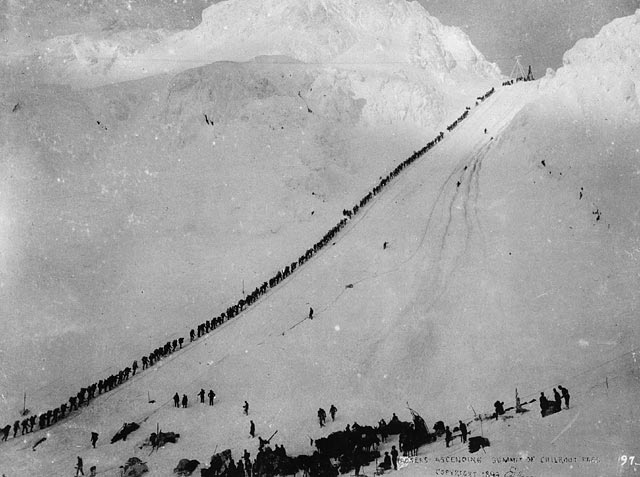The Klondike gold rush is characterized by the vast movement of white prospectors through the Mackenzie Valley in pursuit of Yukon gold fields. This mass of white prospectors were primarily American. Prospectors primarily entered the valley through the Chilkoot Pass, which was a lower area of mountains that allowed prospectors to haul equipment into the valley. This movement elicited issues of land and border disputes that involved indigenous peoples and the United States and Canadian governments. Indigenous people lived on lands that were being entered by prospectors and the Canadian government wished to keep the northern territories peaceful for the use of extracting the valuable resource of gold. So, with the signing of Treaty 8 by Queen Victoria, First Nations from the Lesser Slave Lake area were displaced to an area roughly 840,000 square kilometers. With these actions of the Klondike Gold Rush and the signing of Treaty 8, “Americans and Britons successfully sought gold, displaced native groups, and lived together peaceably” (Arenson, 375-376).
The second major issue that arose during the 1898 Klondike Gold Rush was the dispute between Canadian and American lands. The disagreement occurred along the Alaskan Panhandle where the small towns of Dyea and Skagway were located. These vital port towns allowed access into the Yukon Territory (Petrakos, 366). The port towns were so valuable because they allowed people and supplies to pour into and out of the Yukon Territory. This being said, they were highly profitable, which increased tensions on the dispute over these towns. Canada feared that their land claims on the panhandle would be disregarded as the large migration of Americans to the panhandle area began to overrun the existing Canadian population present on the panhandle. This fear of disputed land spread into the Yukon gold fields as an excessive amount of Americans began to seek their Manifest Destiny. With this anxiety of American migration to the Klondike, the Canadian Government began to advocate for the movement of Canadian miners and the creation of Canadian infrastructure in the Yukon gold fields. This action came in hopes to increase the Canadian presence in the region and to bolster Canadians position in the Yukon Territory.
As a second measure to solidify Canadian territory and the border between Alaska and the Yukon Territory, the Canadian Government dispatched, “the North-West Mounted Police into the territory to establish Canadian sovereignty. These mounted police not only brought law and order to the territory, they also successfully created a border point at the Chilkoot Pass. Chilkoot Pass was the main trail for those who came to the area through the port city of Dyea (Wharton, 1972). The deployment of Mounties was highly important because at the same time the United States had flooded the disputed territory with American troops to protect American claim on the territory. Overall, the Klondike Gold Rush of 1898 was an important instance of Canadian-American border defining and the continued expulsion of aboriginal tribes for the extraction of natural resources.<br>
 Caption: The Chilkoot Pass in the midst of the Klondike Gold Rush of 1898. Prospectors hike up the frigid pass often making multiple trips to haul all of their gear through the pass.<br>
Source: Archives Canada
Caption: The Chilkoot Pass in the midst of the Klondike Gold Rush of 1898. Prospectors hike up the frigid pass often making multiple trips to haul all of their gear through the pass.<br>
Source: Archives Canada
Arenson, Adam. 2007. "Anglo-Saxonism in the Yukon: The Klondike Nugget and American-British Relations in the “Two Wests”; 1898-1901." Pacific Historical Review 76 (3): 373-404.
Petrakos, Christopher. 2016. "William Ogilvie, the Klondike Borderlands and the Making of the Canadian West." The American Review of Canadian Studies 46 (3): 362-379.
Wharton, David. 1972. The Alaska Gold Rush. Bloomington: Indiana University Press.
 Caption: The Chilkoot Pass in the midst of the Klondike Gold Rush of 1898. Prospectors hike up the frigid pass often making multiple trips to haul all of their gear through the pass.<br>
Source:
Caption: The Chilkoot Pass in the midst of the Klondike Gold Rush of 1898. Prospectors hike up the frigid pass often making multiple trips to haul all of their gear through the pass.<br>
Source: